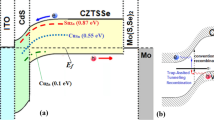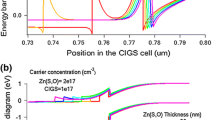Abstract
Buffer layers are commonly used in the optimization of thin-film solar cells. For CuInSe2-and CdTe-based solar cells, multilayer transparent conductors (TCOs, e.g., ZnO or SnO2) are generally used in conjunction with a CdS heterojunction layer. Optimum cell performance is usually found when the TCO layer in contact with the CdS is very resistive or almost insulating. In addition to affecting the open-circuit voltage of a cell, it is commonly reported that buffer layers affect stress-induced degradation and transient phenomena in CdTe- and CuInSe2-based solar cells. In amorphous silicon solar cells, light-induced degradation has a recoverable and a nonrecoverable component too, and the details of the mechanism may depend on the p-type contact layer. Because of the similarity of transients and degradation in dissimilar material systems, it is suggested that degradation and recovery are driven by carriers rather than by diffusing atomic species. The question that must be addressed is why, not how, species diffuse and atomic configurations relax differently in the presence of excess carriers. In this paper, I suggest that the operating conditions of a cell can change the carrier transport properties. Often, excess carriers may enhance the conductance in localized regions (“filaments”) and buffer layers; limiting current flow into such filaments may therefore control the rate and amount of degradation (or recovery).
Similar content being viewed by others
References
B. von Roedern, Proceedings of the 12th European Photovoltaic Solar Energy Conference (H.S. Stephens & Associates, publishers), (1994), pp. 1354–1358.
B.I. Shklovskii and A.L. Efros, Electronic Properties of Doped Semiconductors, Springer-Verlag (Berlin, New York) 1984, (Springer Series in Solid-State Sciences, vol. 45, see p. 310).
B. von Roedern and G.H. Bauer, Mat. Res. Soc. Symp. Proc. Vol. 557 (1999), 761.
R. Harju, V.G. Karpov, D. Grecu, and G. Dorer, J. Appl. Phys. 88 (2000), 1794
J. del Cueto and B. von Roedern, Progress in Photovoltaics: Research and Applications 7, 101, (1999)
T.J. Mc Mahon and M.S. Bennett, Mat. Res. Soc. Symp. Proc. Vol. 258, (1992), p. 941.
V.I. Kaydanov and T.R. Ohno, “Process Development and Basic Studies of Electrochemically Deposited CdT-Based Solar Cells,” Annual Technical Report, Phase I, NREL/SR-520-28762, (2000).
H. Overhof, Mat. Res. Soc. Symp. Proc. Vol. 258, (1992), p. 681.
I.S. Osborne, J. Hajto, A.J. Snell, P.G. LeComber, and A.E. Owen, Mat. Res. Soc. Symp. Proc. Vol. 258, (1992), p. 1169.
This MRS Spring Meeting, Paper A15.2 by M. Luysberg, C. Scholten, L. Houben, O. Vetterl, R. Carius, and F. Finger.
Figure 2 of reference 3 clearly demonstrates how a mobility or a diffusion length that is too large will degrade VOC.
Author information
Authors and Affiliations
Rights and permissions
About this article
Cite this article
von Roedern, B. How do Buffer Layers Affect Solar Cell Performance and Solar Cell Stability?. MRS Online Proceedings Library 668, 69 (2000). https://doi.org/10.1557/PROC-668-H6.9
Published:
DOI: https://doi.org/10.1557/PROC-668-H6.9




